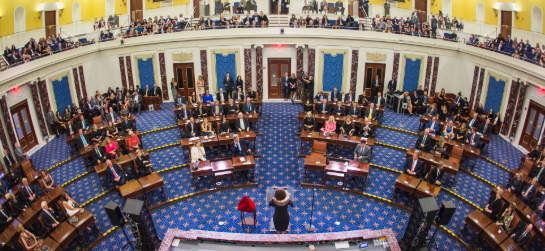Despite a favorable map on paper, Democratic vulnerabilities in Michigan, Minnesota, and a volatile Trump-led environment make the Senate fight a defensive grind.
- Democrats are defending four of the six most competitive Senate seats in 2026, including two open races in Michigan and Minnesota.
- Mallory McMorrow and Kristen McDonald Rivet have declared runs for Michigan’s open seat, while the Republican field remains unsettled.
- Susan Collins’ approval rating has dropped below Donald Trump’s in Maine, raising new questions about her viability in a purple state.
- Wiley Nickel has entered the North Carolina race to challenge Thom Tillis, giving Democrats a known quantity in a tough state.
- 60% of Independents disapprove of Trump’s use of recess appointments, which could shape down-ballot sentiment in key Senate races.
At first glance, the 2026 Senate map looks like a gift to Democrats: they’re defending only 14 seats, compared to 20 for Republicans. But the actual risk is far higher than the numbers suggest. Of the 34 seats on the ballot, only six are rated as competitive—and Democrats are defending four of them. These include Georgia (Ossoff) and New Hampshire (Shaheen), as well as Michigan and Minnesota, both of which will be open-seat contests following retirements.
This means Democrats aren't on offense—they're scrambling to protect vulnerable ground, in some cases without the stabilizing effect of incumbency. Meanwhile, Republicans have the luxury of defending mostly red territory, and only two real battlegrounds: North Carolina and Maine.
Michigan and Minnesota: From Safe to Shaky
In Michigan, Senator Gary Peters’ retirement has blown open a high-stakes contest in a state Democrats won in 2024, but where Trump remains a threat. Two major Democratic candidates have been declared: Mallory McMorrow, a progressive state senator with national fundraising chops, and Kristen McDonald Rivet, a more moderate voice with deep working-class ties. The GOP field remains fluid, though former Rep. John James continues to be floated as a likely contender.
Minnesota faces a similar shift. Senator Tina Smith’s decision to step down transforms a previously safe seat into a lean-Democrat race. Republicans have not yet named a candidate, but the race is expected to draw national money and attention—especially given Trump’s relatively strong performances in the state in both 2016 and 2020.
Without incumbents, both seats are significantly more vulnerable. And in a cycle where Democrats are already stretched, they may not have the resources—or the bench strength—to protect them both.
Trouble in Familiar Territory
Even where Democrats do have incumbents, risk remains. In Georgia, Senator Jon Ossoff will face an energized Republican base, and while the GOP has not yet declared a top challenger, the race is expected to be one of the most expensive in the country. In New Hampshire, Senator Jeanne Shaheen is running again and maintains high favorability, but GOP-aligned groups are still expected to invest in the state. Neither race is a guaranteed hold, especially if national trends break against Democrats.
Republican Targets Plausible
On the other side of the aisle, Republicans are mostly playing defense in safe territory. The exceptions are North Carolina, where Senator Thom Tillis will face a challenge from former U.S. Rep. Wiley Nickel, and Maine, where Senator Susan Collins is facing her most serious reputational challenge in years.
Recent polling shows Collins is now less popular than Donald Trump among Maine voters—an almost unthinkable reversal in a state where she’s long outperformed the national GOP. While she remains the favorite, Democrats view this race as a potential surprise pickup if national momentum shifts in their favor.
Trump’s Second Term and the Recess Appointment Fallout
Donald Trump’s presidency continues to hover over every 2026 race—especially in the Senate. His use of recess appointments to bypass Senate confirmation for Cabinet nominees has become a flashpoint. According to polling tracked by the Partnership for Public Service, 60% of Independents disapprove of the tactic.
In states like Maine, New Hampshire, and North Carolina, that kind of sentiment could push key swing voters away from Trump-aligned Senate candidates. Yet Republicans face a dilemma: distancing themselves from Trump risks alienating their base, while embracing him fully could cost them crucial Independents. Democrats are already framing these Senate races as referenda on Trump’s governing style, hoping to re-create the dynamic that helped them win in 2018.
Internal Shifts and External Pressure
Senate retirements aren’t only a Democratic problem. Mitch McConnell is widely expected to retire in Kentucky, which won’t shift the balance of power but could shape the broader GOP message. Similarly, Tommy Tuberville is rumored to be eyeing a run for governor in Alabama, which would spark another primary battle in a safe red state.
While these seats aren’t in play, the internal reshuffling they trigger can influence national rhetoric—and pull GOP candidates further right in a year where swing voters will have outsized influence.
Wrap Up
The 2026 Senate map gives Democrats little to celebrate. While the numbers suggest a structural edge, the reality is a high-risk cycle with few opportunities and many vulnerabilities. Open seats in Michigan and Minnesota remove the advantages of incumbency in states that are trending more competitive. Races in Georgia and New Hampshire will demand enormous resources, message discipline, and turnout operations that leave no room for missteps.
Republicans, by contrast, have fewer competitive seats to defend and can focus their firepower on just a handful of targets. The complicating factor is Donald Trump. His governing style, especially his use of recess appointments, may cost Republican candidates support among independents in swing states. At the same time, those who break from Trump risk alienating their base.
Democrats are not heading into a wave. They are walking a tightrope. To hold the Senate, they must win every meaningful toss-up and protect every piece of fragile ground they control. The path to a majority still exists, but it is narrow, unforgiving, and demands absolute precision. Anything less, and they will lose it.


